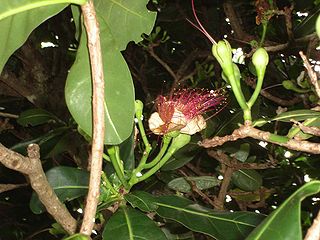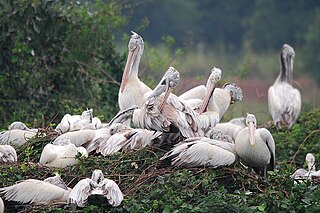
The Lecythidaceae comprise a family of about 20 genera and 250-300 species of woody plants native to tropical South America, Africa, Asia and Australia.
Beefwood is the name given to a number of Australian trees which have timber with a red colouration resembling raw beef as follows:

Barringtonia acutangula is a species of Barringtonia native to coastal wetlands in southern Asia and northern Australasia, from Afghanistan east to the Philippines and Queensland. Common names include freshwater mangrove, itchytree and mango-pine.
Barringtonia payensiana is a species of woody plant in the Lecythidaceae family. It is endemic to Peninsular Malaysia. It is threatened by habitat loss.

Barringtonia is a genus of flowering plants in the family Lecythidaceae first described as a genus with this name in 1775. It is native to Africa, southern Asia, Australia, and various islands of the Pacific and Indian Oceans. The genus name commemorates Daines Barrington.

Barringtonia asiatica is a species of Barringtonia native to mangrove habitats on the tropical coasts and islands of the Indian Ocean and western Pacific Ocean extending from Zanzibar in the east to Taiwan and the Philippines, Japan's Yaeyama Islands and Ogasawara Islands, Fiji, New Caledonia, Solomon Islands, Tuvalu, the Cook Islands, Wallis and Futuna and French Polynesiain the west. It is grown along streets for decorative and shade purposes in some parts of India, for instance in some towns on southeastern shore. It is also known as Box Fruit due the distinct box-shaped fruit it produces. The local name futu is the source of the name for the Polynesian island Futuna. The type specimen was collected by botanist Pehr Osbeck on a sandy beach area on the island of Java, later to be described by Carl Linnaeus in his Species Plantarum in 1753.

Barringtonia calyptrata is a species of mangrove belonging to the family Lecythidaceae. It is native to New Guinea and to northern Queensland.

Barringtonia racemosa is a tree in the family Lecythidaceae. It is found in coastal swamp forests and on the edges of estuaries in the Indian Ocean, starting at the east coast of Mozambique and KwaZulu-Natal to Madagascar, India, Sri Lanka,Malaysia, Maldives, Thailand, Laos, southern China, northern Australia, coastal Taiwan, the Ryukyu Islands and many Polynesian islands.
Acrocercops barringtoniella is a moth of the family Gracillariidae, known from India and Java, Indonesia. The hostplants for the species include Barringtonia acutangula, Barringtonia spicata, Careya arborea, and Planchonia careya.
Barringtonia conoidea grows as a shrub or small tree up to 15 metres (50 ft) tall, with a trunk diameter of up to 15 centimetres (6 in). The fruits are conical, winged, up to 5 cm (2 in) long. Habitat is mangrove forest and along rivers. B. conoidea is found in Burma, Peninsular Malaysia, Sumatra and Borneo.
Barringtonia curranii grows as a tree up to 25 metres (80 ft) tall, with a trunk diameter of up to 40 centimetres (16 in). The bark is grey, greyish green or dark brown. The fruits are ovoid, up to 11 cm (4 in) long. Habitat is forest from sea-level to 1,700 metres (5,600 ft) altitude. B. curranii is found in Borneo and Palawan.
Barringtonia havilandii is a tree of the Lecythidaceae family endemic to Borneo. Its habitat is inland riverine forests.
Barringtonia lanceolata grows as a tree up to 30 metres (100 ft) tall, with a trunk diameter of up to 60 centimetres (24 in). The bark is brown, grey or reddish brown and has been used as fish poison. The fruits are ovoid or fusiform, up to 10.5 cm (4 in) long. Habitat is forest from sea-level to 1,700 metres (5,600 ft) altitude. B. lanceolata is endemic to Borneo.
Barringtonia macrocarpa grows as a shrub or tree up to 30 metres (100 ft) tall, with a trunk diameter of up to 24 centimetres (9 in). The fruits are winged, up to 12.5 cm (5 in) long. Habitat is lowland riverine and swamp forest. B. macrocarpa is found in Burma, Thailand, Vietnam, Malaysia and Indonesia.
Barringtonia macrostachya grows as a shrub or tree up to 30 metres (100 ft) tall, with a trunk diameter of up to 95 centimetres (37 in). The bark is brown, greenish yellow, greyish brown or brown mottled grey. The fruits are obovoid, up to 9 cm (4 in) long. The specific epithet macrostachya is from the Greek meaning "large spike", referring to the inflorescence. Habitat is riverine and swamp forest, from sea-level to 1,300 metres (4,300 ft) altitude. Local medicinal uses include the treatment of ringworm, sore eyes and stomach aches. B. macrostachya has been used as fish poison. It is found in China, Burma, Thailand, Vietnam, Malaysia, Brunei, Indonesia and the Philippines.
Barringtonia pendula grows as a tree up to 47 metres (150 ft) tall, with a trunk diameter of up to 90 centimetres (35 in). The bark is reddish brown. The fruits are ovoid or musiform (banana-shaped), up to 15 cm (6 in) long. The specific epithet pendula is from the Latin meaning "dangling", referring to the inflorescence. Its habitat is dipterocarp forest from sea-level to 1,200 metres (4,000 ft) altitude. B. pendula is found in China, Burma, Thailand, Sumatra, Peninsular Malaysia and Borneo.
Barringtonia reticulata grows as a shrub or small tree up to 10 metres (33 ft) tall, with a trunk diameter of up to 20 centimetres (10 in). The bark is grey. The specific epithet reticulata is from the Latin meaning "like a network", referring to the leaf veins. B. reticulata is found in the Andaman and Nicobar Islands, Malaysia, Brunei and Indonesia.
Barringtonia revoluta grows as a tree up to 33 metres (108 ft) tall, with a trunk diameter of up to 50 centimetres (20 in). The bark is pale brown. The specific epithet revoluta is from the Latin meaning "rolled back", referring to the leaves. Habitat is forests from sea-level to 200 metres (660 ft) altitude. B. revoluta is found in Malaysia, Brunei, Indonesia and the Philippines.

Nelapattu Bird Sanctuary is a bird sanctuary in Nellore district, Andhra Pradesh, India, near the village of Nelapattu. It has an area of 458.92 hectares. It is an important breeding site for spot-billed pelicans.
Mango-pine is a common name for several trees of the genus Barringtonia, which are flowering plants unrelated to actual pines, and may refer to:




